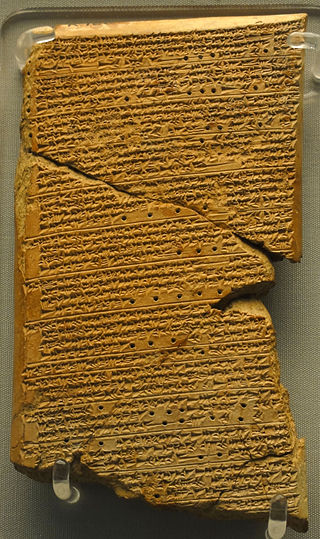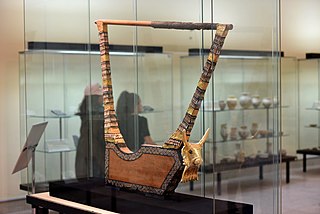Related Research Articles
Ninkasi was the Mesopotamian goddess of beer and brewing. It is possible that in the first millennium BC she was known under the variant name Kurunnītu, derived from a term referring to a type of high quality beer. She was associated with both positive and negative consequences of the consumption of beer. In god lists, such as the An = Anum list and the Weidner god list, she usually appears among the courtiers of the god Enlil, alongside deities such as Ninimma and Ninmada. She could also be paired with Siraš, a goddess of similar character, who sometimes was regarded as her sister. A possible association between her and the underworld deities Nungal and Laṣ is also attested, possibly in reference to the possible negative effects of alcohol consumption.
Siris or Siraš was a Mesopotamian goddess associated with beer. She was also worshiped in Ebla, where her name was spelled as Zilaš. Cognates of her name are also present as terms referring to alcoholic beverages or deities associated with them in languages such as Ugaritic and Hebrew. She was closely associated with another goddess of similar character, Ninkasi, though the nature of the connection between them varies between sources. She is attested in a variety of texts, including god lists, offering lists and a variant of the Ballad of Early Rulers.

Nanaya was a Mesopotamian goddess of love closely associated with Inanna.
Ninti was a Mesopotamian goddess worshiped in Lagash. She was regarded as the mother of Ninkasi. She also appears in the myth Enki and Ninhursag as one of the deities meant to soothe the eponymous god's pain. In this text, her name is reinterpreted first as "lady rib" and then as "lady of the month" through scribal word play.
Aya was a Mesopotamian goddess associated with dawn. Multiple variant names were attributed to her in god lists. She was regarded as the wife of Shamash, the sun god. She was worshiped alongside her husband in Sippar. Multiple royal inscriptions pertaining to this city mention her. She was also associated with the Nadītu community inhabiting it. She is less well attested in the other cult center of Shamash, Larsa, though she was venerated there as well. Additional attestations are available from Uruk, Mari and Assur. Aya was also incorporated into Hurrian religion, and in this context she appears as the wife of Shamash's counterpart Šimige.
Gibil (𒀭𒉈𒄀), also known under the Akkadian name Girra, was a Mesopotamian god associated with fire, both in its positive and negative aspects. He also played a role in ritual purification. Textual sources indicate his symbol was a torch, though no representations of him have been identified in Mesopotamian art. Multiple genealogies could be assigned to him. The god list An = Anum indicates his spouse was Ninirigal. He was also frequently associated with deities such as Shamash, Nuska and Kusu. He is first attested in Early Dynastic texts from Shuruppak, such as offering lists. He was also a member of the pantheon of Eridu. In the Kassite period he was worshiped in Nippur. Later attestations are available from Assyria and from Uruk. He also appears in a number of literary texts.
Ninmena was a Mesopotamian goddess who represented the deified crown. She was closely associated with the deified scepter, Ninĝidru, and with various goddesses of birth, such as Ninhursag.

Ninsianna was a Mesopotamian deity considered to be the personification of Venus. This theonym also served as the name of the planet in astronomical texts until the end of the Old Babylonian period. There is evidence that Ninsianna's gender varied between locations, and both feminine and masculine forms of this deity were worshiped. Due to their shared connection to Venus, Ninsianna was associated with Inanna. Furthermore, the deity Kabta appears alongside Ninsianna in many texts, but the character of the relation between them remains unclear.

Sukkal was a term which could denote both a type of official and a class of deities in ancient Mesopotamia. The historical sukkals were responsible for overseeing the execution of various commands of the kings and acted as diplomatic envoys and translators for foreign dignitaries. The deities referred to as sukkals fulfilled a similar role in mythology, acting as servants, advisors and envoys of the main gods of the Mesopotamian pantheon, such as Enlil or Inanna. The best known sukkal is the goddess Ninshubur. In art, they were depicted carrying staves, most likely understood as their attribute. They could function as intercessory deities, believed to mediate between worshipers and the major gods.
Ašratum was a Mesopotamian goddess of Amorite origin. She was regarded as the wife of the god Amurru. Her name is a cognate of Ugaritic Athirat, but despite likely sharing the same origin these two goddesses occupied different positions in the respective pantheons.
Ninmug or Ninmuga was a Mesopotamian goddess. She was associated with artisanship, especially with metalworking, as evidenced by her epithet tibira kalamma, "metalworker of the land." She could also be regarded as a goddess of birth and assistant of Ninmah, most likely because the fashioning of statues of deities and the birth of children could be described with the same terms in Sumerian texts. Her main cult centers were Kisiga, whose location remains uncertain, and Adab.
Ningublaga was a Mesopotamian god associated with cattle. His cult center was Kiabrig, a little known city located in the proximity of Ur. He belonged to the circle of deities related to the moon god, Nanna, and sometimes could be viewed as his son. He is also well attested as the brother of Alammuš, and they frequently appear together in god lists, incantations and especially in astronomical texts.

Ningizibara, also known as Igizibara and Ningizippara, was a Mesopotamian goddess associated with the balaĝ instrument, usually assumed to be a type of lyre. She could be regarded both as a physical instrument and as a minor deity. In both cases, she was associated with the goddess Inanna. A connection between her and the medicine goddess Gula is also attested, and it is possible she could serve as a minor healing deity herself.
Ninĝidru was a Mesopotamian goddess who most likely represented a deified scepter. She played a role in coronation rituals. She often appears in association with Ninmena, who represented the deified crown. A recently published hymn additionally attests that she was the sukkal of Sud, the tutelary goddess of Shuruppak.
Nin-MAR.KI was a Mesopotamian goddess. The reading and meaning of her name remain uncertain, though options such as Ninmar and Ninmarki can be found in literature. In the past the form Ninkimar was also in use. She was considered the divine protector of cattle, and additionally functioned as an oath deity. She might have been associated with long distance trade as well. It is possible that in art she was depicted in the company of birds, similar to her mother Nanshe. Other deities associated with her include other members of the pantheon Lagash, such as Dumuzi-abzu and Hendursaga.
Mes-sanga-Unug was a Mesopotamian god closely associated with the city of Uruk, and especially with one of its districts, Kullaba. He was regarded as a warrior deity. In early sources he was described as the "great ensi of Inanna," but later on he was seemingly associated with Anu instead. He belonged to the earliest pantheon of Uruk, though he ceased to be worshiped there in the Ur III period, and the attestations in documents from the reign of the Seleucids are assumed to be a result of a late reintroduction. He was also venerated in Babylon, where he had two temples. Further attestations from outside Uruk come from various god lists.
Urkayītu, also known as Urkītum, was a Mesopotamian goddess who likely functioned as the divine representation of the city of Uruk. Her name was initially an epithet of Inanna, but later she came to be viewed as a separate goddess. She was closely associated with Uṣur-amāssu, and like her belonged to the pentad of main goddesses of Uruk in the Neo-Babylonian period. She also continued to be worshiped in this city under Achaemenid and Seleucid rule.

Epithets of Inanna were titles and bynames used to refer to this Mesopotamian goddess and to her Akkadian counterpart Ishtar. In Mesopotamia, epithets were commonly used in place of the main name of the deity, and combinations of a name with an epithet similar to these common in ancient Greek religion are comparatively uncommon. Inanna had more titles than any other Mesopotamian deity. They pertained to her associations with specific cities or areas, such as Uruk, Zabalam, Akkad, Nineveh, or the Sealand. Others instead highlighted her specific roles, for example, that of an astral goddess personifying the planet Venus—or that of a war deity. In some cases, her individual epithets eventually developed into separate deities.

Inanna of Zabalam was a hypostasis of the Mesopotamian goddess Inanna associated with the city of Zabalam. It has been proposed that she was initially a separate deity, perhaps known under the name Nin-UM, who came to be absorbed by the goddess of Uruk at some point in the prehistory of Mesopotamia and lost her unknown original character in the process, though in certain contexts she nonetheless could still be treated as distinct. She was regarded as the mother of Shara, the god of Umma, a city located near Zabalam.
Ancestors of Enlil or Enki-Ninki deities were a group of Mesopotamian deities. Individual lists do not agree on their number, though the enumerations always start with the pair Enki and Ninki and end with Enlil. In the earliest recorded lists, Enki and Ninki were the immediate parents of Enlil, but beginning in the Ur III period onwards, a growing number of 'ancestors' separated them. Enki and Ninki became primordial, ancestral beings who were no longer active and resided in the underworld. They could be invoked in exorcisms. They are attested in various texts, including god lists, incantations, prayers and myths.
References
- 1 2 Beaulieu 2003, p. 121.
- 1 2 3 4 Asher-Greve & Westenholz 2013, p. 49.
- 1 2 Krebernik 1998, p. 386.
- ↑ Krul 2018, pp. 86–87.
- 1 2 Krul 2018, p. 87.
- 1 2 3 Krebernik 1998, p. 387.
- ↑ Krul 2018, p. 67.
- ↑ Krul 2018, p. 50.
- ↑ Peterson 2014, p. 309.
- ↑ Krul 2018, p. 73.
- ↑ Krul 2018, p. 75.
- ↑ Krebernik 2011, p. 606.
- ↑ Cavigneaux & Krebernik 1998, pp. 614–615.
- 1 2 Peterson 2014, p. 308.
- ↑ Cavigneaux & Krebernik 1998, p. 615.
- ↑ Peterson 2014, pp. 308–309.
- ↑ Krebernik 1998a, p. 457.
- ↑ Krebernik 1998a, p. 455.
Bibliography
- Asher-Greve, Julia M.; Westenholz, Joan G. (2013). Goddesses in Context: On Divine Powers, Roles, Relationships and Gender in Mesopotamian Textual and Visual Sources (PDF). Academic Press Fribourg. ISBN 978-3-7278-1738-0 . Retrieved 2022-08-19.
- Beaulieu, Paul-Alain (2003). The pantheon of Uruk during the neo-Babylonian period. Leiden Boston: Brill STYX. ISBN 978-90-04-13024-1. OCLC 51944564.
- Cavigneaux, Antoine; Krebernik, Manfred (1998), "Nun-bar-a/una", Reallexikon der Assyriologie (in German), retrieved 2022-08-19
- Krebernik, Manfred (1998), "Nin-irigala", Reallexikon der Assyriologie (in German), retrieved 2022-08-19
- Krebernik, Manfred (1998a), "Ninlil", Reallexikon der Assyriologie (in German), retrieved 2022-08-19
- Krebernik, Manfred (2011), "Sonnengott A. I. In Mesopotamien. Philologisch", Reallexikon der Assyriologie (in German), retrieved 2022-08-19
- Krul, Julia (2018). The Revival of the Anu Cult and the Nocturnal Fire Ceremony at Late Babylonian Uruk. Brill. doi:10.1163/9789004364943. ISBN 9789004364936.
- Peterson, Jeremiah (2014). "Two New Sumerian Texts Involving the Deities Numushda and Gibil". Studia Mesopotamica: Jahrbuch für altorientalische Geschichte und Kultur. Band 1. Münster: Ugarit-Verlag. ISBN 978-3-86835-076-0. OCLC 952181311.